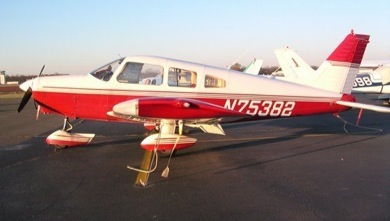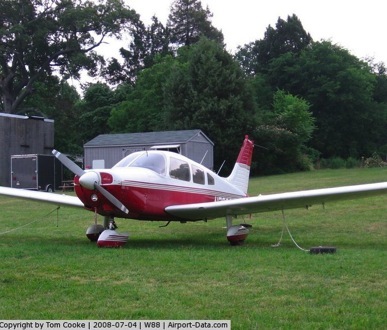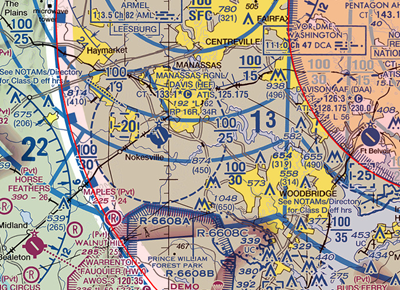Coming across the FAA Flying Club based at Manassas Regional Airport (HEF) automatically got my journalistic instincts excited. For the past couple of years AOPA has been leading the Flying Club Initiative as a tool to help increase the pilot population and strengthen a means to provide pilots with affordable and fun flying opportunities. Here would be a great way to see how the agency that regulates aviation in America is connected to the effort.
What I found instead was a club that isn’t affiliated with the FAA anymore, but has been around for more than 50 years and recently made some changes to pull itself out of a steady descent and is once again climbing.
“The club was founded in 1962 by a bunch of FAA employees, but they really focused more on government employees,” Club President Mike Hilton said. “It wasn’t exclusive. That’s where the name came from and we just kept it as part of our legacy.”
 Today the club has 17 members and owns a 1976 Piper Warrior (PA28-151) with the upgraded 160-hp engine. Its mission to promote aviation safety and provide an opportunity to increase participation in general aviation has changed very little over the past 50 years.
Today the club has 17 members and owns a 1976 Piper Warrior (PA28-151) with the upgraded 160-hp engine. Its mission to promote aviation safety and provide an opportunity to increase participation in general aviation has changed very little over the past 50 years.
However, some costly annuals and investments in a new interior and a new engine in the past five years resulted in the club building up a considerable amount of debt.
“When our current leadership took over we really dug into our finances and cut a lot of costs to make things more efficient,” Mike said. “There was some inattention to detail. Some membership dues weren’t getting collected. The club used to have two airplanes. For years we were paying for two tie downs, with one airplane.”
The club reviewed all of its debt, how much it cost to fly the plane, and how much the club was making when the plane was flown. It considered changing the fee structure, but decided against it. A few changes were made to the bylaws and some debt was refinanced, putting the club on a path to be debt free by next year.
“Our biggest thing was, the more the plane flies, the better we’re going to be financially,” Mike said. “So the number one priority is to make sure the plane is in good shape. If you have a good, reliable, safe airplane, people will fly it.”
 The club established a regular maintenance schedule, and with the new interior and engine, the plane is now flying five or six times a week.
The club established a regular maintenance schedule, and with the new interior and engine, the plane is now flying five or six times a week.
Most club members use the Warrior for local $100-hamburger flights or training with one of the three or four CFIs in the club. There are a few primary students and a few former military pilots that want to get back into the cockpit.
“The Warrior is an inexpensive way to get yourself back in there, do the Rusty Pilot thing,” Mike said. “Guys also use the Warrior to keep their instrument currency up. In terms of keeping your 90-day and six-month currency, there’s not a cheaper way to do it.”
Navigating DC Airspace
Flying in the airspace around the nation’s capital might be a bit daunting to a new pilot or someone who has been out of the cockpit for awhile. The biggest factor is the Special Flight Rules Area (SFRA) and Flight Restricted Zone (FRZ). Add to that three Class Bravo airports – Dulles (IAD), Reagan National (DCA), and Baltimore-Washington (BWI) – and several military operations areas and there is a lot to be aware of in a relatively small region.
“I think people are intimidated by it because it seems really busy, but I send solo students out. If a solo student can do it, anybody can,” Mike said. “It’s really straightforward. The SFRA is sort of a quasi-IFR. You fly under VFR rules but you’re talking and squawking. The only real issue is making sure you have a flight plan.”
From Manassas it’s 12.5 miles as the crow flies to the nearest gate to enter or exit the SFRA and once you're out, you can resume flying VFR without having to talk to anyone.
“AOPA has some online training for the SFRA that explains it really well,” Mike said. “You’re required to take that training and carry a little card that says I’ve done my SFRA training.”
Even transiting through the SFRA from Manassas to Maryland’s Eastern Shore or toward New York, Mike said the only real challenge is staying out of the Class Bravo or getting clearance through it, which isn’t hard to do. He also said he doesn’t find the airspace gets in the way of either training or pleasure flying.
“When I want to go to the northeast, I’ll get a Dulles Surface Bravo transition. I’ve never been denied,” Mike said. “It’s just like when you pick up an IFR clearance. You file your flight plan, say you want to go to the Wooly gate, which is the northern gate, you take off out of here, the tower hands you off to Potomac [TRACON], you stay outside the Class B, once they pick up the squawk they say ‘radar contact,’ which is the magic word because when you go out of here they usually just say ‘transponder observed.’ Then they give you a vector and they basically fly you up the western edge of the FRZ. And once you’re clear of that, they tell you to proceed direct Wooly, they give you a climb to your VFR altitude and you’re off an running.
“Coming back, as soon as you start talking to Potomac, the first controller you talk to, you ask to start working your Class B clearance. It cuts about 40 minutes off you trip because you can go through the Surface Bravo.”
Although the FAA Flying Club is not affiliated with the agency, it does provide an opportunity for pilots to fly in the complicated airspace that surrounds Washington, DC and to do so at a reasonable cost. But more importantly, it’s a great example of a club that has been around for a while that has taken the time to evaluate its operations and make changes to put itself on a stronger financial footing.
Factsheet
|
Name |
FAA Flying Club |
|
Location |
Manassas Regional Airport (KHEF), Manassas, VA |
|
Website |
|
|
Year formed |
1962 |
|
Aircraft |
1976 Piper PA-151 Warrior with 160 hp upgrade ($115/hr) Rates are Tach hours, wet. |
|
Joining fee |
$500 non-refundable |
|
Monthly dues |
$70 per month |
|
Membership |
17 |
|
Scheduler |
Aircraftclubs.com |